A Comprehensive Evaluation of Three Global Surface Longwave Radiation Products
Abstract
:1. Introduction
2. Data
2.1. Ground Measurements
2.2. CERES SYN 1deg Edition 4A
2.3. ERA5 Reanalysis
2.4. GLASS Surface Longwave Radiation Product
3. Methods
3.1. Data Processing
3.2. Evaluation Metrics
3.3. Mann–Kendall Trend Test
4. Results and Discussion
4.1. Validation with Ground Measurements
4.1.1. Direct Validation
4.1.2. Spatial Representativeness of the Direct Validation Results
4.1.3. Spatial Distribution of the Validation Results
4.2. Cross-Evaluation with the GLASS Surface LW Radiation Product
4.3. Global Annual Mean of Surface LW Radiation
4.3.1. Spatial Distribution of the Global Annual Mean Surface LW Radiation
| Products | SLUR (W/m2) | SLDR (W/m2) | Time | Reference |
|---|---|---|---|---|
| CERES early | 396 | 333 | March 2002–May 2004 | Trenberth, Fasullo and Kiehl [2] |
| ERA-Interim | 397.7 | 341.2 | 1989–2008 | Berrisford, Kållberg, Kobayashi, Dee, Uppala, Simmons, Poli and Sato [26] |
| CERES | 398 | 345.6 | 2000–2010 | Stephens, Li, Wild, Clayson, Loeb, Kato, L’Ecuyer, Stackhouse, Lebsock and Andrews [22] |
| CERES EBAF | 398 | 344 | March 2000–February 2010 | Kato, et al. [58] |
| CERES, ISCCP-FD, 2B-FLXHR-lidar and C3M | 399 | 341 | 2000–2009 | L’Ecuyer, Beaudoing, Rodell, Olson, Lin, Kato, Clayson, Wood, Sheffield and Adler [28] |
| 43 CMIP5 climate models, ERA | 399.9 | 343.8 | 2000–2014 | Wild [29] |
| GLASS | 399.77/378.98/408.54 | 342.64/311.34/355.86 | 2003–2020 | This study |
| CERES SYN | 398.92/380/409.26 | 347.98/322.38/361.96 | 2003–2020 | This study |
| ERA5 | 398.19/375.38/408.38 | 340.47/308.39/354.95 | 2003–2020 | This study |
4.3.2. Temporal Variation in the Annual Mean Surface LW Radiation
5. Conclusions
Author Contributions
Funding
Data Availability Statement
Conflicts of Interest
Appendix A
| Region | Product | Sky Conditions | SLUR (W/m2) | SLDR (W/m2) | ||||
|---|---|---|---|---|---|---|---|---|
| Bias | Std_Bias | RMSE | Bias | Std_Bias | RMSE | |||
| North America | GLASS | All-sky | −6.07 | 20.98 | 21.84 | −7.04 | 36.19 | 36.87 |
| Clear-sky | −5.06 | 14.61 | 15.46 | −5.21 | 24.63 | 25.17 | ||
| Cloud-sky | −4.82 | 21.51 | 22.05 | −14.36 | 38.18 | 40.79 | ||
| ERA5 | All-sky | 0.2 | 19.87 | 19.87 | −6 | 21.62 | 22.44 | |
| Clear-sky | −3.44 | 21.82 | 22.09 | −4.08 | 18.8 | 19.24 | ||
| Cloud-sky | 1.38 | 19.04 | 19.09 | −6.61 | 22.42 | 23.38 | ||
| CERES SYN | All-sky | 1.88 | 29.17 | 29.23 | 2.1 | 34.95 | 35.01 | |
| Clear-sky | −1.46 | 26.47 | 26.51 | 9.36 | 33.72 | 35 | ||
| Cloud-sky | 2.97 | 29.92 | 30.07 | −0.23 | 35.02 | 35.02 | ||
| Asia | GLASS | All-sky | −5.13 | 26 | 26.5 | −11.7 | 39.59 | 41.29 |
| Clear-sky | −7.89 | 19.7 | 21.22 | −8.26 | 24.86 | 26.19 | ||
| Cloud-sky | −3.36 | 26.43 | 26.64 | −16.68 | 41.07 | 44.33 | ||
| ERA5 | All-sky | −0.52 | 23.06 | 23.07 | −13.92 | 24.9 | 28.53 | |
| Clear-sky | −4.04 | 24.99 | 25.32 | −13.71 | 21.56 | 25.55 | ||
| Cloud-sky | −0.11 | 22.79 | 22.79 | −13.94 | 25.23 | 28.82 | ||
| CERES SYN | All-sky | −0.63 | 27.24 | 27.24 | −7.2 | 33.03 | 33.81 | |
| Clear-sky | −6.37 | 22.9 | 23.77 | 4.54 | 34.26 | 34.56 | ||
| Cloud-sky | 0.05 | 27.63 | 27.63 | −8.44 | 32.66 | 33.73 | ||
| Europe | GLASS | All-sky | −10.93 | 17.56 | 20.69 | −15.77 | 35.54 | 38.88 |
| Clear-sky | −9.43 | 13.1 | 16.15 | −4.94 | 19.36 | 19.98 | ||
| Cloud-sky | −9.63 | 16.12 | 18.78 | −22.76 | 34.53 | 41.36 | ||
| ERA5 | All-sky | −5.01 | 15.7 | 16.48 | −9.06 | 21.03 | 22.9 | |
| Clear-sky | −5.64 | 19.48 | 20.28 | −4.65 | 13.17 | 13.96 | ||
| Cloud-sky | −4.96 | 15.35 | 16.13 | −9.39 | 21.47 | 23.43 | ||
| CERES SYN | All-sky | −7.36 | 21.56 | 22.78 | −5.66 | 32.96 | 33.44 | |
| Clear-sky | −3.19 | 23.8 | 24.01 | 3.34 | 31.22 | 31.39 | ||
| Cloud-sky | −7.69 | 21.34 | 22.68 | −6.33 | 32.98 | 33.59 | ||
| South America | GLASS | All-sky | −15.05 | 18.59 | 23.91 | −7.74 | 35.67 | 36.5 |
| Clear-sky | −11.8 | 8.92 | 14.79 | 1.86 | 22.97 | 23.05 | ||
| Cloud-sky | −12.41 | 17.67 | 21.59 | −15.64 | 35.36 | 38.66 | ||
| ERA5 | All-sky | 0.33 | 14.09 | 14.1 | −4.43 | 25.03 | 25.42 | |
| Clear-sky | −8.37 | 12.5 | 15.04 | 3.56 | 23.45 | 23.72 | ||
| Cloud-sky | 0.43 | 14.08 | 14.09 | −5.06 | 25.05 | 25.55 | ||
| CERES SYN | All-sky | 3.85 | 23.88 | 24.19 | 1.68 | 31.37 | 31.42 | |
| Clear-sky | −3.76 | 20.45 | 20.79 | 16.19 | 30 | 34.09 | ||
| Cloud-sky | 3.93 | 23.9 | 24.23 | 0.55 | 31.2 | 31.2 | ||
| Antarctica | GLASS | All-sky | −5 | 13.01 | 13.94 | 12.2 | 35.22 | 37.27 |
| Clear-sky | −1.74 | 8.71 | 8.88 | 37.4 | 16.59 | 40.91 | ||
| Cloud-sky | −7.1 | 14.6 | 16.23 | −8.71 | 31.75 | 32.93 | ||
| ERA5 | All-sky | 3.49 | 12.03 | 12.53 | −8.64 | 24.83 | 26.29 | |
| Clear-sky | −1.58 | 13.13 | 13.22 | −13.93 | 21.59 | 25.69 | ||
| Cloud-sky | 4.31 | 11.64 | 12.41 | −7.78 | 25.21 | 26.39 | ||
| CERES SYN | All-sky | −3.05 | 16.2 | 16.48 | −4.56 | 31.6 | 31.93 | |
| Clear-sky | 0.02 | 12.39 | 12.39 | 5.96 | 27.66 | 28.29 | ||
| Cloud-sky | −3.54 | 16.68 | 17.05 | −6.26 | 31.87 | 32.48 | ||
| Arctic | GLASS | All-sky | −9.52 | 18.11 | 20.46 | −13.2 | 34.69 | 37.12 |
| Clear-sky | −10.67 | 13.69 | 17.35 | −3.29 | 26 | 26.2 | ||
| Cloud-sky | −8.38 | 17.78 | 19.66 | −16.67 | 34.98 | 38.75 | ||
| ERA5 | All-sky | −2.93 | 16.98 | 17.23 | −12.25 | 25.91 | 28.66 | |
| Clear-sky | −6.2 | 18.25 | 19.28 | −19.13 | 23.67 | 30.44 | ||
| Cloud-sky | −2.59 | 16.81 | 17.01 | −11.54 | 26.02 | 28.47 | ||
| CERES SYN | All-sky | −7.07 | 22.4 | 23.49 | −12.01 | 34.21 | 36.26 | |
| Clear-sky | −5.92 | 18.06 | 19.01 | −4.01 | 32.58 | 32.82 | ||
| Cloud-sky | −7.19 | 22.8 | 23.91 | −12.84 | 34.27 | 36.6 | ||
| Globe | GLASS | All-sky | −7.63 | 19.5 | 20.94 | −8.22 | 36.71 | 37.62 |
| Clear-sky | −6.75 | 14.18 | 15.7 | 2.61 | 28.02 | 28.14 | ||
| Cloud-sky | −7.01 | 15.96 | 20.78 | −15.86 | 36.18 | 39.5 | ||
| ERA5 | All-sky | −1.05 | 18.34 | 18.37 | −9.41 | 24.14 | 25.92 | |
| Clear-sky | −4.17 | 20.52 | 20.94 | −9.16 | 21.39 | 23.26 | ||
| Cloud-sky | −0.48 | 17.85 | 17.86 | −9.45 | 24.59 | 26.35 | ||
| CERES SYN | All-sky | −3.18 | 25.15 | 25.35 | −5.57 | 34.22 | 34.67 | |
| Clear-sky | −2.85 | 23.28 | 23.46 | 5.29 | 33.07 | 33.49 | ||
| Cloud-sky | −3.24 | 25.47 | 25.68 | −7.42 | 34.06 | 34.86 | ||
References
- Stephens, G.L.; L’Ecuyer, T. The Earth’s energy balance. Atmos. Res. 2015, 166, 195–203. [Google Scholar] [CrossRef]
- Trenberth, K.E.; Fasullo, J.T.; Kiehl, J. Earth’s Global Energy Budget. Bull. Amer. Meteorol. Soc. 2009, 90, 311–323. [Google Scholar] [CrossRef] [Green Version]
- Liang, S.; Wang, D.; He, T.; Yu, Y. Remote sensing of Earth’s energy budget: Synthesis and review. Int. J. Digit. Earth 2019, 12, 737–780. [Google Scholar] [CrossRef] [Green Version]
- Zhang, Y.C.; Rossow, W.; Lacis, A. Calculation of surface and top of atmosphere radiative fluxes from physical quantities based on ISCCP data sets: 1. Method and sensitivity to input data uncertainties. J. Geophys. Res. Atmos. 1995, 100, 1149–1165. [Google Scholar] [CrossRef]
- Zhang, Y.C.; Rossow, W.B.; Lacis, A.A.; Oinas, V.; Mishchenko, M.I. Calculation of radiative fluxes from the surface to top of atmosphere based on ISCCP and other global data sets: Refinements of the radiative transfer model and the input data. J. Geophys. Res. Atmos. 2004, 109, 1–27. [Google Scholar] [CrossRef] [Green Version]
- Fu, Q.; Liou, K.N. Parameterization of the radiative properties of cirrus clouds. J. Atmos. Sci. 1993, 50, 2008–2025. [Google Scholar] [CrossRef]
- Pinker, R.T.; Tarpley, J.D.; Laszlo, I.; Mitchell, K.E.; Houser, P.R.; Wood, E.F.; Schaake, J.C.; Robock, A.; Lohmann, D.; Cosgrove, B.A.; et al. Surface radiation budgets in support of the GEWEX Continental-Scale International Project (GCIP) and the GEWEX Americas Prediction Project (GAPP), including the North American Land Data Assimilation System (NLDAS) Project. J. Geophys. Res. Atmos. 2003, 108, 1–18. [Google Scholar] [CrossRef]
- Doelling, D.R.; Loeb, N.G.; Keyes, D.F.; Nordeen, M.L.; Morstad, D.; Nguyen, C.; Wielicki, B.A.; Young, D.F.; Sun, M. Geostationary enhanced temporal interpolation for CERES flux products. J. Atmos. Ocean. Technol. 2013, 30, 1072–1090. [Google Scholar] [CrossRef]
- Doelling, D.R.; Sun, M.; Nguyen, L.T.; Nordeen, M.L.; Haney, C.O.; Keyes, D.F.; Mlynczak, P.E. Advances in geostationary-derived longwave fluxes for the CERES synoptic (SYN1deg) product. J. Atmos. Ocean. Technol. 2016, 33, 503–521. [Google Scholar] [CrossRef]
- Hersbach, H.; Bell, B.; Berrisford, P.; Hirahara, S.; Horányi, A.; Muñoz-Sabater, J.; Nicolas, J.; Peubey, C.; Radu, R.; Schepers, D.; et al. The ERA5 global reanalysis. Q. J. R. Meteorolog. Soc. 2020, 146, 1999–2049. [Google Scholar] [CrossRef]
- Stackhouse, P.W., Jr.; Gupta, S.K.; Cox, S.J.; Zhang, T.; Mikovitz, J.C.; Hinkelman, L.M. The NASA/GEWEX surface radiation budget release 3.0: 24.5-year dataset. Gewex News 2011, 21, 10–12. [Google Scholar]
- Draper, C.S.; Reichle, R.H.; Koster, R.D. Assessment of MERRA-2 land surface energy flux estimates. J. Clim. 2018, 31, 671–691. [Google Scholar] [CrossRef]
- Von Schuckmann, K.; Palmer, M.; Trenberth, K.E.; Cazenave, A.; Chambers, D.; Champollion, N.; Hansen, J.; Josey, S.; Loeb, N.; Mathieu, P.-P. An imperative to monitor Earth’s energy imbalance. Nat. Clim. Chang. 2016, 6, 138–144. [Google Scholar] [CrossRef] [Green Version]
- Liang, S.; Cheng, J.; Jia, K.; Jiang, B.; Liu, Q.; Xiao, Z.; Yao, Y.; Yuan, W.; Zhang, X.; Zhao, X. The global Land surface satellite (GLASS) product suite. Bull. Amer. Meteorol. Soc. 2021, 102, E323–E337. [Google Scholar] [CrossRef]
- Gui, S.; Liang, S.; Li, L. Evaluation of satellite-estimated surface longwave radiation using ground-based observations. J. Geophys. Res. 2010, 115, 1–16. [Google Scholar] [CrossRef] [Green Version]
- Kratz, D.P.; Gupta, S.K.; Wilber, A.C.; Sothcott, V.E. Validation of the CERES Edition-4A Surface-Only Flux Algorithms. J. Appl. Meteorol. Climatol. 2020, 59, 281–295. [Google Scholar] [CrossRef]
- Tang, W.; Qin, J.; Yang, K.; Zhu, F.; Zhou, X. Does ERA5 outperform satellite products in estimating atmospheric downward longwave radiation at the surface? Atmos. Res. 2021, 252, 105453. [Google Scholar] [CrossRef]
- Wang, G.; Wang, T.; Xue, H. Validation and comparison of surface shortwave and longwave radiation products over the three poles. Int. J. Appl. Earth Obs. Geoinf. 2021, 104, 102538. [Google Scholar] [CrossRef]
- Yan, H.; Huang, J.; Minnis, P.; Wang, T.; Bi, J. Comparison of CERES surface radiation fluxes with surface observations over Loess Plateau. Remote Sens. Environ. 2011, 115, 1489–1500. [Google Scholar] [CrossRef] [Green Version]
- Zeng, Q.; Cheng, J.; Dong, L. Assessment of the Long-Term High-Spatial-Resolution Global LAnd Surface Satellite (GLASS) Surface Longwave Radiation Product Using Ground Measurements. IEEE J. Sel. Top. Appl. Earth Observ. Remote Sens. 2020, 13, 2032–2055. [Google Scholar] [CrossRef]
- Zhang, T.; Stackhouse, P.W.; Gupta, S.K.; Cox, S.J.; Mikovitz, J.C. The validation of the GEWEX SRB surface longwave flux data products using BSRN measurements. J. Quant. Spectrosc. Radiat. Transf. 2015, 150, 134–147. [Google Scholar] [CrossRef]
- Stephens, G.L.; Li, J.; Wild, M.; Clayson, C.A.; Loeb, N.; Kato, S.; L’Ecuyer, T.; Stackhouse, P.W.; Lebsock, M.; Andrews, T. An update on Earth’s energy balance in light of the latest global observations. Nat. Geosci. 2012, 5, 691–696. [Google Scholar] [CrossRef]
- Kiehl, J.T.; Trenberth, K.E. Earth’s annual global mean energy budget. Bull. Amer. Meteorol. Soc. 1997, 78, 197–208. [Google Scholar] [CrossRef]
- Ohmura, A.; Gilgen, H. Re-evaluation of the global energy balance. Wash. DC Am. Geophys. Union Geophys. Monogr. Ser. 1993, 75, 93–110. [Google Scholar]
- Wild, M.; Folini, D.; Hakuba, M.Z.; Schär, C.; Seneviratne, S.I.; Kato, S.; Rutan, D.; Ammann, C.; Wood, E.F.; König-Langlo, G. The energy balance over land and oceans: An assessment based on direct observations and CMIP5 climate models. Clim. Dyn. 2015, 44, 3393–3429. [Google Scholar] [CrossRef] [Green Version]
- Berrisford, P.; Kållberg, P.; Kobayashi, S.; Dee, D.; Uppala, S.; Simmons, A.J.; Poli, P.; Sato, H. Atmospheric conservation properties in ERA-Interim. Q. J. R. Meteorolog. Soc. 2011, 137, 1381–1399. [Google Scholar] [CrossRef]
- Bosilovich, M.G.; Robertson, F.R.; Chen, J. Global energy and water budgets in MERRA. J. Clim. 2011, 24, 5721–5739. [Google Scholar] [CrossRef]
- L’Ecuyer, T.S.; Beaudoing, H.K.; Rodell, M.; Olson, W.; Lin, B.; Kato, S.; Clayson, C.; Wood, E.; Sheffield, J.; Adler, R. The observed state of the energy budget in the early twenty-first century. J. Clim. 2015, 28, 8319–8346. [Google Scholar] [CrossRef] [Green Version]
- Wild, M. The global energy balance as represented in CMIP6 climate models. Clim. Dyn. 2020, 55, 553–577. [Google Scholar] [CrossRef]
- Wild, M. Progress and challenges in the estimation of the global energy balance. In Proceedings of the AIP Conference Proceedings, Auckland, New Zealand, 16–22 April 2017; p. 020004. [Google Scholar]
- Baldocchi, D.; Falge, E.; Gu, L.; Olson, R.; Hollinger, D.; Running, S.; Anthoni, P.; Bernhofer, C.; Davis, K.; Evans, R. FLUXNET: A new tool to study the temporal and spatial variability of ecosystem-scale carbon dioxide, water vapor, and energy flux densities. Bull. Amer. Meteorol. Soc. 2001, 82, 2415–2434. [Google Scholar] [CrossRef]
- Ohmura, A.; Dutton, E.G.; Forgan, B.; Fröhlich, C.; Gilgen, H.; Hegner, H.; Heimo, A.; König-Langlo, G.; McArthur, B.; Müller, G.; et al. Baseline Surface Radiation Network (BSRN/WCRP): New Precision Radiometry for Climate Research. Bull. Am. Meteorol. Soc. 1998, 79, 2115–2136. [Google Scholar] [CrossRef]
- Zhao, P.; Xu, X.; Chen, F.; Guo, X.; Zheng, X.; Liu, L.; Hong, Y.; Li, Y.; La, Z.; Peng, H. The Third Atmospheric Scientific Experiment for understanding the earth–atmosphere coupled system over the Tibetan Plateau and its effects. Bull. Am. Meteorol. Soc. 2018, 99, 757–776. [Google Scholar] [CrossRef]
- Liu, S.; Xu, Z.; Song, L.; Zhao, Q.; Yong, G.; Xu, T.; Ma, Y.; Zhu, Z.; Jia, Z.; Zhang, F. Upscaling evapotranspiration measurements from multi-site to the satellite pixel scale over heterogeneous land surfaces. Agric. For. Meteorol. 2016, 230, 97–113. [Google Scholar] [CrossRef]
- Zeng, Q.; Cheng, J. Estimating high-spatial resolution surface daily longwave radiation from the instantaneous Global LAnd Surface Satellite (GLASS) longwave radiation product. Int. J. Digit. Earth 2021, 14, 1674–1704. [Google Scholar] [CrossRef]
- Rutan, D.A.; Kato, S.; Doelling, D.R.; Rose, F.G.; Nguyen, L.T.; Caldwell, T.E.; Loeb, N.G. CERES Synoptic Product: Methodology and Validation of Surface Radiant Flux. J. Atmos. Ocean. Technol. 2015, 32, 1121–1143. [Google Scholar] [CrossRef]
- Kato, S.; Rose, F.G.; Charlock, T.P. Computation of domain-averaged irradiance using satellite-derived cloud properties. J. Atmos. Ocean. Technol. 2005, 22, 146–164. [Google Scholar] [CrossRef] [Green Version]
- Morcrette, J.; Barker, H.W.; Cole, J.; Iacono, M.J.; Pincus, R. Impact of a new radiation package, McRad, in the ECMWF Integrated Forecasting System. Mon. Weather Rev. 2008, 136, 4773–4798. [Google Scholar] [CrossRef]
- Morcrette, J.J. Radiation and cloud radiative properties in the European Centre for Medium Range Weather Forecasts forecasting system. J. Geophys. Res. Atmos. 1991, 96, 9121–9132. [Google Scholar] [CrossRef]
- Cheng, J.; Liang, S. Global Estimates for High-Spatial-Resolution Clear-Sky Land Surface Upwelling Longwave Radiation from MODIS Data. IEEE Trans. Geosci. Remote Sens. 2016, 54, 4115–4129. [Google Scholar] [CrossRef]
- Cheng, J.; Liang, S.; Wang, W.; Guo, Y. An efficient hybrid method for estimating clear-sky surface downward longwave radiation from MODIS data. J. Geophys. Res. Atmos. 2017, 122, 2616–2630. [Google Scholar] [CrossRef]
- Cheng, J.; Liang, S. Estimating the broadband longwave emissivity of global bare soil from the MODIS shortwave albedo product. J. Geophys. Res. Atmos. 2014, 119, 614–634. [Google Scholar] [CrossRef]
- Cheng, J.; Liang, S.; Verhoef, W.; Shi, L.; Liu, Q. Estimating the hemispherical broadband longwave emissivity of global vegetated surfaces using a radiative transfer model. IEEE Trans. Geosci. Remote Sens. 2016, 54, 905–917. [Google Scholar] [CrossRef]
- Forman, B.A.; Margulis, S.A. Estimates of total downwelling surface radiation using a high-resolution GOES-based cloud product along with MODIS and AIRS products. Am. Geophys. Union 2007, 52, Abstract H31A-0134. [Google Scholar]
- Ma, Q.; Wang, K.; Wild, M. Impact of geolocations of validation data on the evaluation of surface incident shortwave radiation from Earth System Models. J. Geophys. Res. Atmos. 2015, 120, 6825–6844. [Google Scholar] [CrossRef] [Green Version]
- Wehbe, Y.; Temimi, M. A remote sensing-based assessment of water resources in the Arabian Peninsula. Remote Sens. 2021, 13, 247. [Google Scholar] [CrossRef]
- Machiwal, D.; Gupta, A.; Jha, M.K.; Kamble, T. Analysis of trend in temperature and rainfall time series of an Indian arid region: Comparative evaluation of salient techniques. Theor. Appl. Climatol. 2019, 136, 301–320. [Google Scholar] [CrossRef]
- Yang, F.; Cheng, J. A framework for estimating cloudy sky surface downward longwave radiation from the derived active and passive cloud property parameters. Remote Sens. Environ. 2020, 248, 111972. [Google Scholar] [CrossRef]
- Gupta, S.K. A Parameterization for Longwave Surface Radiation from Sun-Synchronous Satellite Data. J. Clim. 1989, 2, 305–320. [Google Scholar] [CrossRef]
- Key, J.R.; Schweiger, A.J.; Stone, R.S. Expected uncertainty in satellite-derived estimates of the surface radiation budget at high latitudes. J. Geophys. Res. Oceans 1997, 102, 15837–15847. [Google Scholar] [CrossRef]
- Riihelä, A.; Key, J.R.; Meirink, J.F.; Kuipers Munneke, P.; Palo, T.; Karlsson, K.G. An intercomparison and validation of satellite-based surface radiative energy flux estimates over the Arctic. J. Geophys. Res. 2017, 122, 4829–4848. [Google Scholar] [CrossRef]
- Zhou, S.; Cheng, J. An improved temperature and emissivity separation algorithm for the advanced Himawari imager. IEEE Trans. Geosci. Remote Sens. 2020, 58, 7105–7124. [Google Scholar] [CrossRef]
- Liang, S.; Fang, H.; Chen, M.; Shuey, C.J.; Walthall, C.; Daughtry, C.; Morisette, J.; Schaaf, C.; Strahler, A. Validating MODIS land surface reflectance and albedo products: Methods and preliminary results. Remote Sens. Environ. 2002, 83, 149–162. [Google Scholar] [CrossRef]
- Yan, G.; Wang, T.; Jiao, Z.; Mu, X.; Zhao, J.; Chen, L. Topographic radiation modeling and spatial scaling of clear-sky land surface longwave radiation over rugged terrain. Remote Sens. Environ. 2016, 172, 15–27. [Google Scholar] [CrossRef]
- Zhang, X.; Liang, S.; Wang, K.; Li, L.; Gui, S. Analysis of Global Land Surface Shortwave Broadband Albedo from Multiple Data Sources. IEEE J. Sel. Top. Appl. Earth Observ. Remote Sens. 2010, 3, 296–305. [Google Scholar] [CrossRef]
- Jia, A.; Liang, S.; Jiang, B.; Zhang, X.; Wang, G. Comprehensive Assessment of Global Surface Net Radiation Products and Uncertainty Analysis. J. Geophys. Res. Atmos. 2018, 123, 1970–1989. [Google Scholar] [CrossRef]
- Wang, K.; Dickinson, R.E. Global atmospheric downward longwave radiation at the surface from ground-based observations, satellite retrievals, and reanalyses. Rev. Geophys. 2013, 51, 150–185. [Google Scholar] [CrossRef]
- Kato, S.; Loeb, N.G.; Rose, F.G.; Doelling, D.R.; Rutan, D.A.; Caldwell, T.E.; Yu, L.; Weller, R.A. Surface irradiances consistent with CERES-derived top-of-atmosphere shortwave and longwave irradiances. J. Clim. 2013, 26, 2719–2740. [Google Scholar] [CrossRef]
- Xue, P.; Liu, H.; Zhang, M.; Gong, H.; Cao, L. Nonlinear Characteristics of NPP Based on Ensemble Empirical Mode Decomposition from 1982 to 2015—A Case Study of Six Coastal Provinces in Southeast China. Remote Sens. 2021, 14, 15. [Google Scholar] [CrossRef]
- Donohoe, A.; Marshall, J.; Ferreira, D.; Mcgee, D. The relationship between ITCZ location and cross-equatorial atmospheric heat transport: From the seasonal cycle to the Last Glacial Maximum. J. Clim. 2013, 26, 3597–3618. [Google Scholar] [CrossRef]
- Zhou, S.; Cheng, J.; Shi, J. A physical-based framework for estimating the hourly all-weather land surface temperature by synchronizing geostationary satellite observations and land surface model simulations. IEEE Trans. Geosci. Remote Sens. 2022, 60, 1–22. [Google Scholar] [CrossRef]
- Dong, S.; Cheng, J.; Shi, J.; Shi, C.; Sun, S.; Liu, W. A Data Fusion Method for Generating Hourly Seamless Land Surface Temperature from Himawari-8 AHI Data. Remote Sens. 2022, 14, 5170. [Google Scholar] [CrossRef]
- Xu, S.; Cheng, J. A new land surface temperature fusion strategy based on cumulative distribution function matching and multiresolution Kalman filtering. Remote Sens. Environ. 2021, 254, 112256. [Google Scholar] [CrossRef]
- Liu, W.; Cheng, J.; Wang, Q. Estimating Hourly All-weather Land Surface Temperature from FY-4A/AGRI imagery using the Surface Energy Balance Theory. IEEE Trans. Geosci. Remote Sens. 2023, 61, 1–18. [Google Scholar] [CrossRef]
- Shi, J.; Cheng, J.; Dong, S. 1 km seamless land surface temperature dataset of China (2002–2020). Remote Sens. Environ. 2021, 254, 112256. [Google Scholar] [CrossRef]
- Cheng, J.; Dong, S.; Shi, J. 0.02° seamless hourly land surface temperature dataset over East Asia (2016–2021). Remote Sens. 2022, 14, 51. [Google Scholar] [CrossRef]
- Yang, F.; Cheng, J.; Zeng, Q. Validation of a Cloud-Base Temperature-Based Single-Layer Cloud Model for Estimating Surface Longwave Downward Radiation. IEEE Geosci. Remote Sens. Lett. 2021, 19, 1–5. [Google Scholar] [CrossRef]
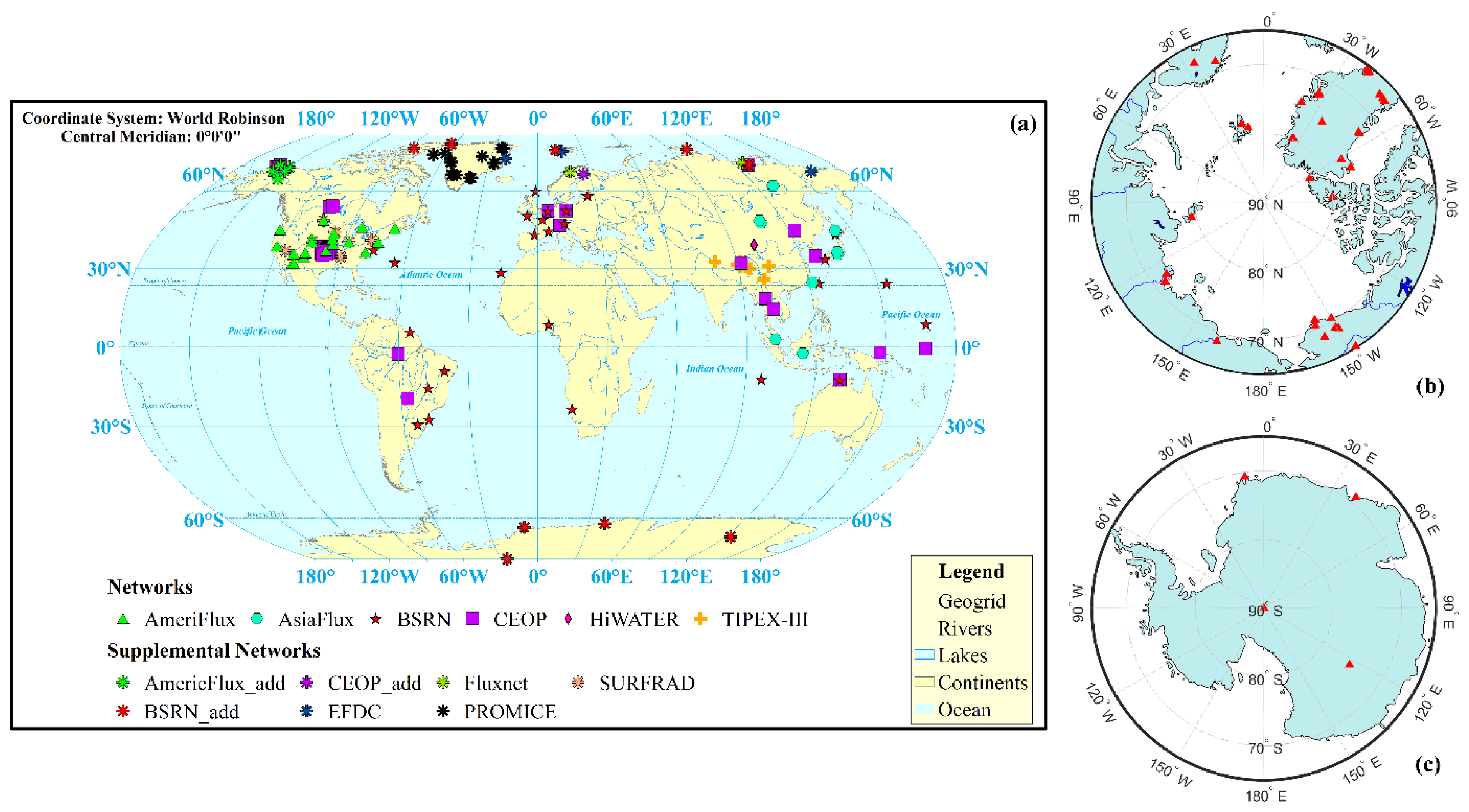



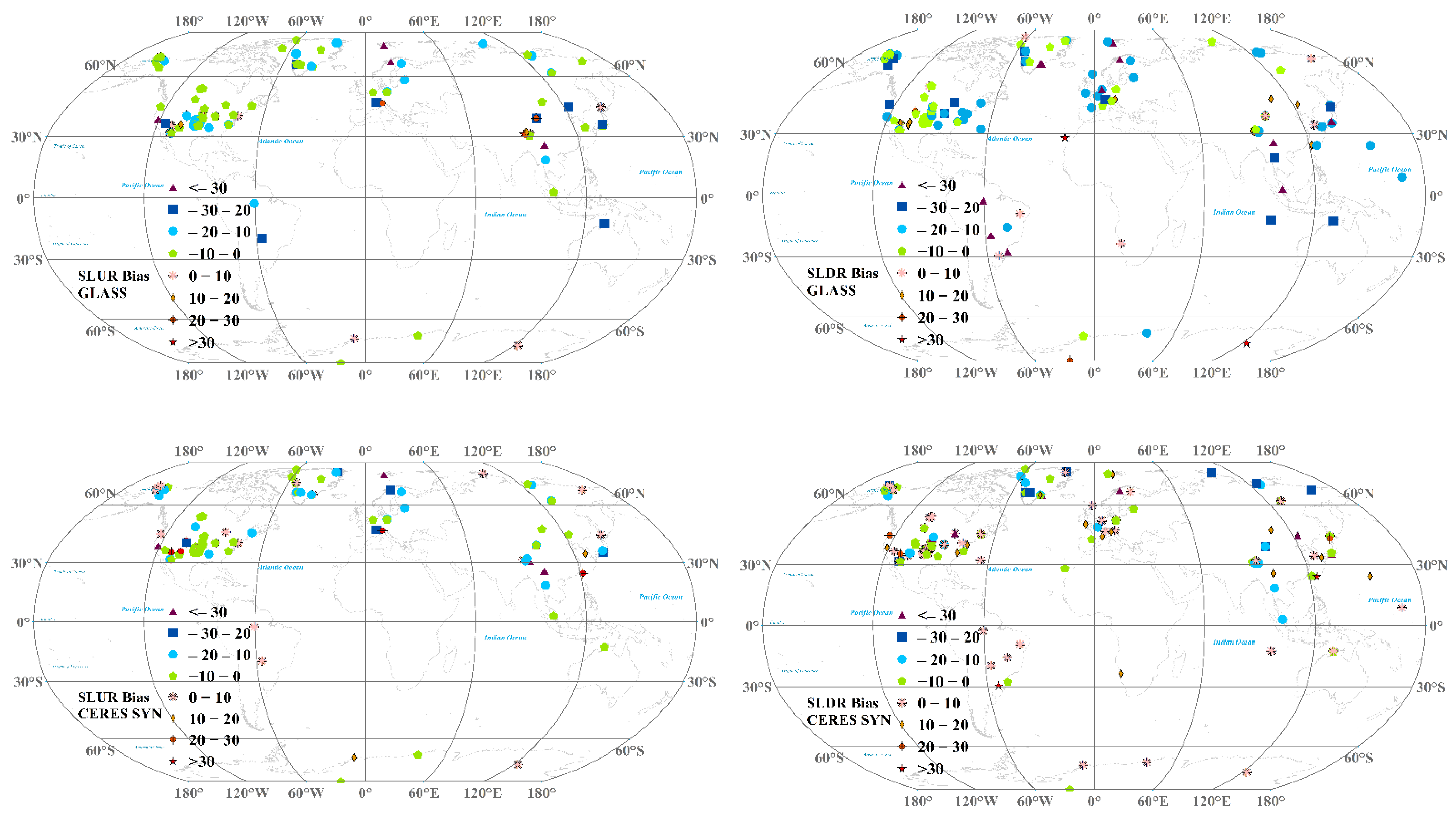

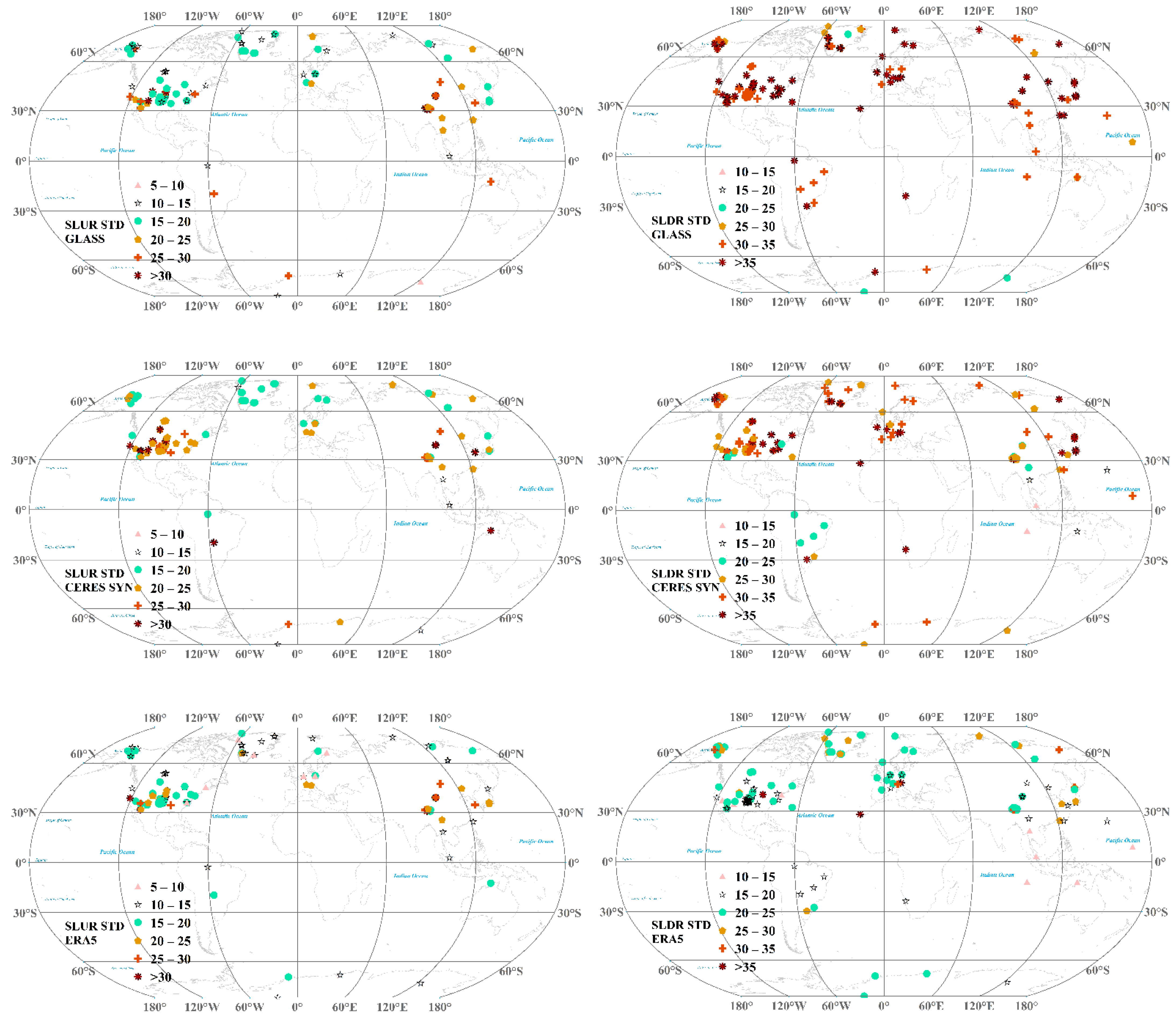


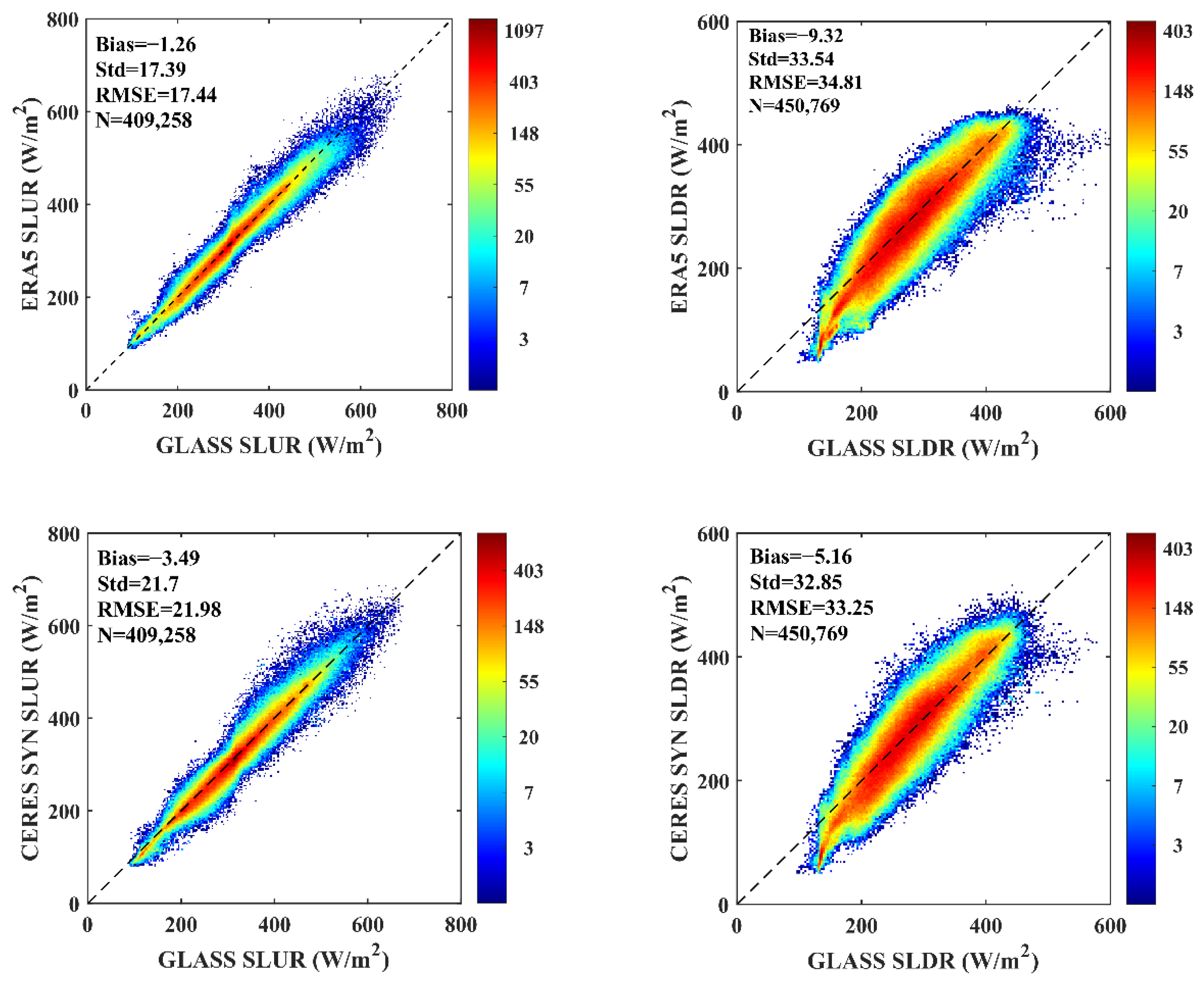

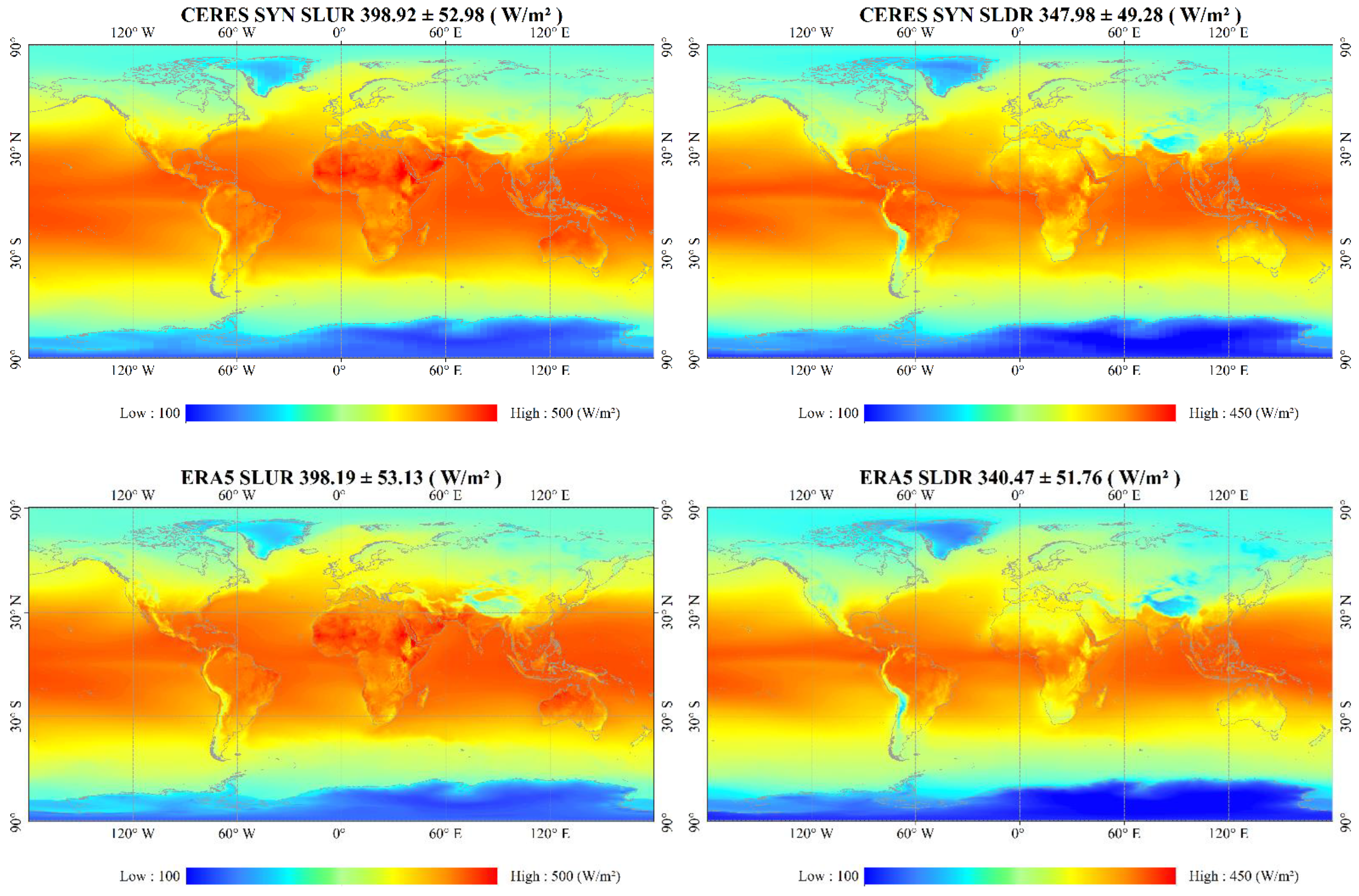
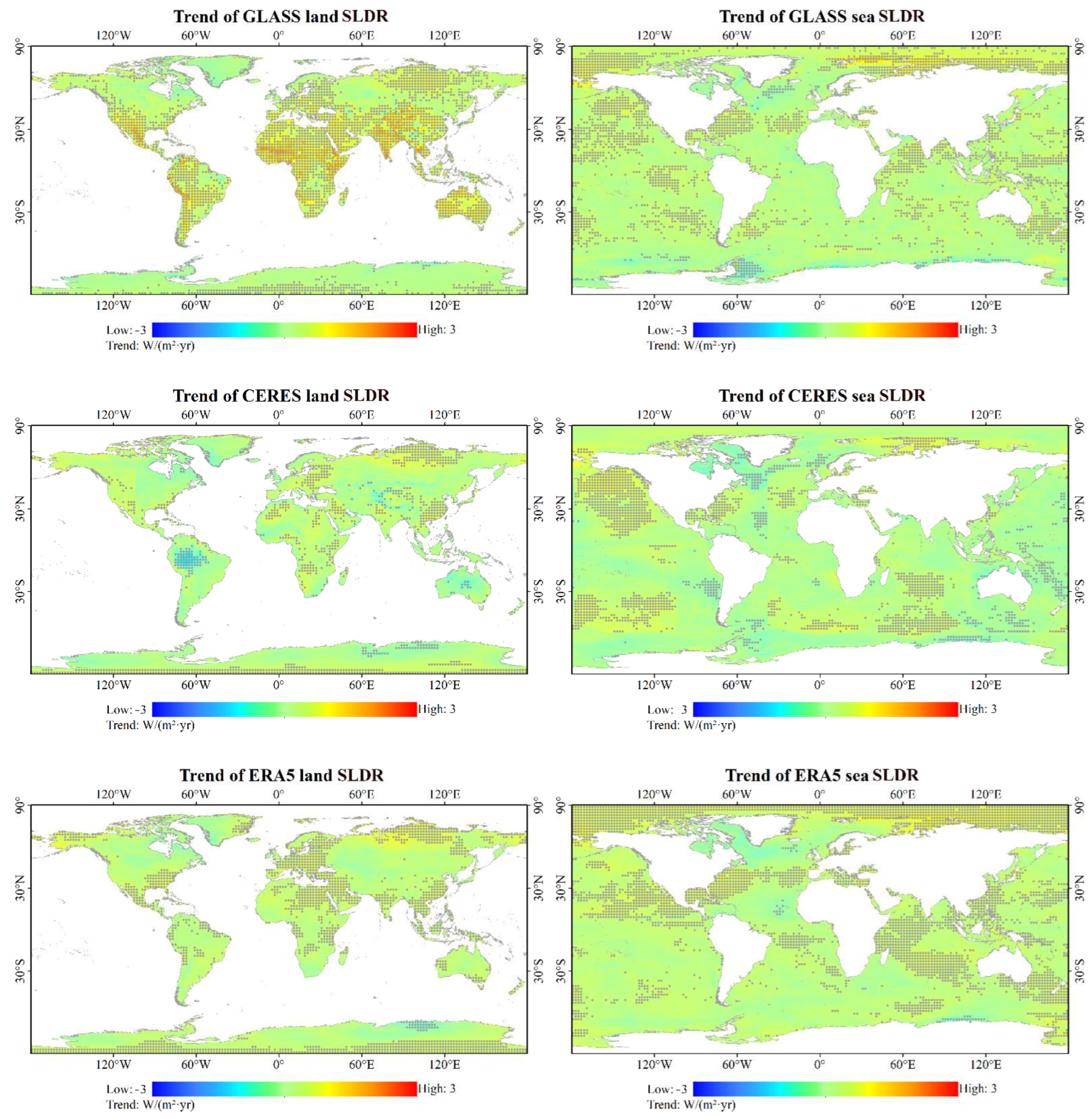





| No. | Network | No. of Sites | Time Resolution (min) | URL |
|---|---|---|---|---|
| 1 | AsiaFlux | 10 | 30 | http://asiaflux.net/, accessed on 1 June 2023 |
| 2 | AmeriFlux | 40 | 30 | https://ameriflux.lbl.gov/, accessed on 1 June 2023 |
| 3 | BSRN | 35 | 1 | https://bsrn.awi.de/, accessed on 1 June 2023 |
| 4 | CEOP | 41 | 30 | https://www.eol.ucar.edu/field_projects/ceop, accessed on 1 June 2023 |
| 5 | EFDC | 2 | 60 | http://www.europe-fluxdata.eu/, accessed on 1 June 2023 |
| 6 | FluxNet | 2 | 30 | https://fluxnet. fluxdata.org/, accessed on 1 June 2023 |
| 7 | HiWATER-MUSOEXE | 19 | 10 | https://data.tpdc.ac.cn/zh-hans/, accessed on 1 June 2023 |
| 8 | PROMICE | 14 | 60 | http://www.promice.org/, accessed on 1 June 2023 |
| 9 | SURFRAD | 7 | 1 | https://gml.noaa.gov/grad/surfrad/index.html, accessed on 1 June 2023 |
| 10 | TIPEX-III | 11 | 10 | http://123.56.215.19/tipex, accessed on 1 June 2023 |
| Case | Description |
|---|---|
| Case 1 (clear sky) | The cloud QCs of all GLASS SLDR pixels in 25 km are equal to 3, and the cloud amount of the ERA5 grid is 0 |
| Case 2 (partly cloudy sky) | Broken clouds in ERA5 with the cloud amount between 0.05~1, and the corresponding GLASS QCs may be equal to 0, 1, 2 and 3 in 25 km |
| Case 3 (cloud sky) | The cloud QCs of all GLASS SLDR pixels in 25 km are controlled to 0, and the cloud amount of ERA5 is 1 |
Disclaimer/Publisher’s Note: The statements, opinions and data contained in all publications are solely those of the individual author(s) and contributor(s) and not of MDPI and/or the editor(s). MDPI and/or the editor(s) disclaim responsibility for any injury to people or property resulting from any ideas, methods, instructions or products referred to in the content. |
© 2023 by the authors. Licensee MDPI, Basel, Switzerland. This article is an open access article distributed under the terms and conditions of the Creative Commons Attribution (CC BY) license (https://creativecommons.org/licenses/by/4.0/).
Share and Cite
Zeng, Q.; Cheng, J.; Guo, M. A Comprehensive Evaluation of Three Global Surface Longwave Radiation Products. Remote Sens. 2023, 15, 2955. https://doi.org/10.3390/rs15122955
Zeng Q, Cheng J, Guo M. A Comprehensive Evaluation of Three Global Surface Longwave Radiation Products. Remote Sensing. 2023; 15(12):2955. https://doi.org/10.3390/rs15122955
Chicago/Turabian StyleZeng, Qi, Jie Cheng, and Mengfei Guo. 2023. "A Comprehensive Evaluation of Three Global Surface Longwave Radiation Products" Remote Sensing 15, no. 12: 2955. https://doi.org/10.3390/rs15122955
APA StyleZeng, Q., Cheng, J., & Guo, M. (2023). A Comprehensive Evaluation of Three Global Surface Longwave Radiation Products. Remote Sensing, 15(12), 2955. https://doi.org/10.3390/rs15122955







